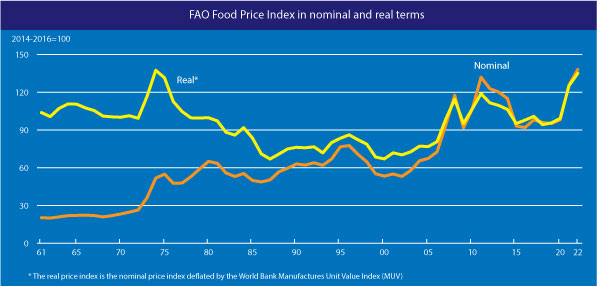From the Food and Agriculture Organization of the United Nations, March 4:
» The FAO Food Price Index* (FFPI) averaged 140.7 points in February 2022, up 5.3 points (3.9 percent) from January and as much as 24.1 points (20.7 percent) above its level a year ago. This represents a new all-time high, exceeding the previous top of February 2011 by 3.1 points. The February rise was led by large increases in vegetable oil and dairy price sub-indices. Cereals and meat prices were also up, while the sugar price sub-index fell for the third consecutive month.

» The FAO Cereal Price Index averaged 144.8 points in February, up 4.2 points (3.0 percent) from January and 18.7 points (14.8 percent) from one year ago. In February, prices of all major cereals increased from their respective values last month. World wheat prices increased by 2.1 percent, largely reflecting new global supply uncertainties amidst disruptions in the Black Sea region that could potentially hinder exports from Ukraine and the Russian Federation, two major wheat exporters. Coarse grain export prices also rose by 4.7 percent. World maize prices increased by 5.1 percent month-on-month, underpinned by a combination of continued crop condition concerns in Argentina and Brazil, rising wheat prices, and uncertainty regarding maize exports from Ukraine, a major exporter. Among other coarse grains, both sorghum and barley export prices firmed month-on-month as well, gaining 5.9 and 2.7 percent, respectively. International rice prices increased by 1.1 percent in February, primarily sustained by the appreciation of currencies of some exporters against the US dollar and strong demand for fragrant rice from Near East Asian buyers.
» The FAO Vegetable Oil Price Index averaged 201.7 points in February, up 15.8 points (8.5 percent) month-on-month and marking a new record high. The continued price strength mostly stemmed from rising palm, soy, and sunflower oil prices. In February, international palm oil prices increased for the second consecutive month due to the sustained global import demand that coincided with reduced export availabilities from Indonesia, the world’s leading palm oil exporter. In the meantime, world soyoil values continued to rise on deteriorating soybean production prospects in South America. International sunflower oil prices also increased markedly, underpinned by concerns over the disruptions in the Black Sea region, which could potentially lower exports. Surging crude oil prices also lent support to the vegetable oil complex.
» The FAO Dairy Price Index averaged 141.1 points in February, up 8.5 points (6.4 percent) from January, marking the sixth successive monthly increase and placing the index 28.0 points (24.8 percent) above its value in the corresponding month last year. In February, international quotations for all dairy products represented in the index firmed, underpinned by the continued tightening of global markets on the back of lower than expected milk supplies in Western Europe and Oceania. Besides tight global supplies, persistent import demand, especially from North Asia and the Middle East, led to steep increases in whole milk powder and cheese price quotations. International skim milk powder prices rose significantly as well, reflecting a lower volume of milk deliveries for drying plants in Western Europe, while butter prices received a boost from high demand for spot supplies.
» The FAO Meat Price Index* averaged 112.8 points in February, up 1.2 points (1.1 percent) month-on-month and 15.0 points (15.3 percent) from its level a year ago. In February, international bovine meat quotations reached a new record high, driven by strong global import demand amidst tight supplies of slaughter-ready cattle in Brazil and high demand for herd rebuilding in Australia. Pig meat prices also edged up, reflecting increased internal demand and scaled-back hog supplies in the European Union and the United States of America. Quotations for ovine meat weakened for the fourth consecutive month due to high exportable supplies in Oceania. Meanwhile, poultry meat prices fell slightly due to reduced imports by China following the end of the Spring Festival and lower domestic demand in Brazil....
....MUCH MORE